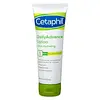What's inside
What's inside
 Key Ingredients
Key Ingredients

 Benefits
Benefits

 Concerns
Concerns

 Ingredients Side-by-side
Ingredients Side-by-side

Water
Skin ConditioningGlycerin
HumectantHydrogenated Polyisobutene
EmollientCetearyl Alcohol
EmollientMacadamia Integrifolia Seed Oil
Skin ConditioningButyrospermum Parkii Butter
Skin ConditioningCyclopentasiloxane
EmollientAcrylates/C10-30 Alkyl Acrylate Crosspolymer
Emulsion StabilisingSodium Polyacrylate
AbsorbentPhenoxyethanol
PreservativeTocopheryl Acetate
AntioxidantCeteareth-20
CleansingStearoxytrimethylsilane
EmollientStearyl Alcohol
EmollientBenzyl Alcohol
PerfumingFarnesol
PerfumingSodium PCA
HumectantPanthenol
Skin ConditioningDimethiconol
EmollientCitric Acid
BufferingSodium Hydroxide
BufferingWater, Glycerin, Hydrogenated Polyisobutene, Cetearyl Alcohol, Macadamia Integrifolia Seed Oil, Butyrospermum Parkii Butter, Cyclopentasiloxane, Acrylates/C10-30 Alkyl Acrylate Crosspolymer, Sodium Polyacrylate, Phenoxyethanol, Tocopheryl Acetate, Ceteareth-20, Stearoxytrimethylsilane, Stearyl Alcohol, Benzyl Alcohol, Farnesol, Sodium PCA, Panthenol, Dimethiconol, Citric Acid, Sodium Hydroxide
Water
Skin ConditioningGluconolactone
Skin ConditioningButylene Glycol
HumectantIsocetyl Stearate
EmollientGlyceryl Stearate
EmollientPEG-100 Stearate
Isododecane
EmollientTriethanolamine
BufferingCyclopentasiloxane
EmollientPalmitic Acid
EmollientStearic Acid
CleansingMacadamia Ternifolia Seed Oil
EmollientArginine
MaskingGlycerin
HumectantC12-15 Alkyl Benzoate
AntimicrobialDimethicone
EmollientDiisostearyl Malate
EmollientCetyl Ricinoleate
EmollientCetearyl Alcohol
EmollientTocopheryl Acetate
AntioxidantOenothera Biennis Oil
EmollientCyclohexasiloxane
EmollientMyristic Acid
CleansingMagnesium Aluminum Silicate
AbsorbentSteareth-2
EmulsifyingXanthan Gum
EmulsifyingDisodium EDTA
Caprylyl Glycol
EmollientPhenoxyethanol
PreservativeChlorphenesin
AntimicrobialWater, Gluconolactone, Butylene Glycol, Isocetyl Stearate, Glyceryl Stearate, PEG-100 Stearate, Isododecane, Triethanolamine, Cyclopentasiloxane, Palmitic Acid, Stearic Acid, Macadamia Ternifolia Seed Oil, Arginine, Glycerin, C12-15 Alkyl Benzoate, Dimethicone, Diisostearyl Malate, Cetyl Ricinoleate, Cetearyl Alcohol, Tocopheryl Acetate, Oenothera Biennis Oil, Cyclohexasiloxane, Myristic Acid, Magnesium Aluminum Silicate, Steareth-2, Xanthan Gum, Disodium EDTA, Caprylyl Glycol, Phenoxyethanol, Chlorphenesin
Ingredients Explained
These ingredients are found in both products.
Ingredients higher up in an ingredient list are typically present in a larger amount.
Cetearyl alcohol is a mixture of two fatty alcohols: cetyl alcohol and stearyl alcohol. It is mainly used as an emulsifier. Emulsifiers help prevent the separation of oils and products. Due to its composition, it can also be used to thicken a product or help create foam.
Cetearyl alcohol is an emollient. Emollients help soothe and hydrate the skin by trapping moisture.
Studies show Cetearyl alcohol is non-toxic and non-irritating. The FDA allows products labeled "alcohol-free" to have fatty alcohols.
This ingredient is usually derived from plant oils such as palm, vegetable, or coconut oils. There is debate on whether this ingredient will cause acne.
Due to the fatty acid base, this ingredient may not be Malassezia folliculitis safe.
Learn more about Cetearyl AlcoholCyclopentasiloxane, or D5, is a silicone used to improve texture of products and trap moisture.
D5 is considered lightweight and volatile. Volatile means it evaporates quickly after application. Once evaporated, D5 leaves a thin barrier that helps keep skin hydrated.
It is also an emollient. Emollients help soften the skin and prevent water loss. Silicones create a silky texture in products. D5 helps other ingredients become more spreadable.
Studies show D5 is safe to use in skincare products. We recommend speaking with a skincare professional if you have concerns.
Learn more about CyclopentasiloxaneGlycerin is already naturally found in your skin. It helps moisturize and protect your skin.
A study from 2016 found glycerin to be more effective as a humectant than AHAs and hyaluronic acid.
As a humectant, it helps the skin stay hydrated by pulling moisture to your skin. The low molecular weight of glycerin allows it to pull moisture into the deeper layers of your skin.
Hydrated skin improves your skin barrier; Your skin barrier helps protect against irritants and bacteria.
Glycerin has also been found to have antimicrobial and antiviral properties. Due to these properties, glycerin is often used in wound and burn treatments.
In cosmetics, glycerin is usually derived from plants such as soybean or palm. However, it can also be sourced from animals, such as tallow or animal fat.
This ingredient is organic, colorless, odorless, and non-toxic.
Glycerin is the name for this ingredient in American English. British English uses Glycerol/Glycerine.
Learn more about GlycerinPhenoxyethanol is a preservative that has germicide, antimicrobial, and aromatic properties. Studies show that phenoxyethanol can prevent microbial growth. By itself, it has a scent that is similar to that of a rose.
It's often used in formulations along with Caprylyl Glycol to preserve the shelf life of products.
Tocopheryl Acetate is AKA Vitamin E. It is an antioxidant and protects your skin from free radicals. Free radicals damage the skin by breaking down collagen.
One study found using Tocopheryl Acetate with Vitamin C decreased the number of sunburned cells.
Tocopheryl Acetate is commonly found in both skincare and dietary supplements.
Learn more about Tocopheryl AcetateWater. It's the most common cosmetic ingredient of all. You'll usually see it at the top of ingredient lists, meaning that it makes up the largest part of the product.
So why is it so popular? Water most often acts as a solvent - this means that it helps dissolve other ingredients into the formulation.
You'll also recognize water as that liquid we all need to stay alive. If you see this, drink a glass of water. Stay hydrated!
Learn more about Water